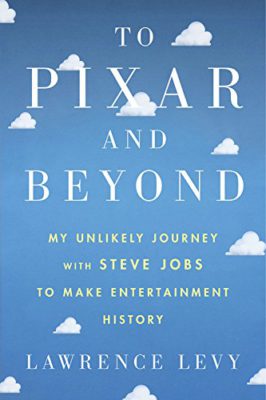 At the beginning of 2006 Disney bought Pixar for $7.4 billion, one of the first milestones in Bob Iger’s tenure as CEO. Recognizing that this was a likely scenario, I purchased my first share of stock in Pixar when I was 19 to get what I imagined would become a highly collectible stock certificate. But what I never knew was the challenging road to not only make Pixar more than just a one-hit wonder, but also the struggle to go public and just how involved Steve Jobs was.
At the beginning of 2006 Disney bought Pixar for $7.4 billion, one of the first milestones in Bob Iger’s tenure as CEO. Recognizing that this was a likely scenario, I purchased my first share of stock in Pixar when I was 19 to get what I imagined would become a highly collectible stock certificate. But what I never knew was the challenging road to not only make Pixar more than just a one-hit wonder, but also the struggle to go public and just how involved Steve Jobs was.
In his new book To Pixar and Beyond, Lawrence Levy reveals the untold business side of Pixar’s rise to the top and the challenges that went with it. Hand picked by Jobs to be Pixar’s first CFO, Levy shares what it was like in the days leading up to the completion of Toy Story. Meet young(er) John Lasseter, Ed Catmull, and the entire crew at Pixar who poured everything they had into a company that had very little chance of surviving.
Levy understands that this book will have mass appeal, so he sheds light on many business practices and terms to make all readers feel welcome at his table. His writing style makes you feel like he’s a close friend recounting these events and followers of Steve Jobs’ career and personal life will feel like they’re at a reunion. For Disney history fans, Levy paints a picture of what made Michael Eisner such a powerful CEO at Disney in the early 1990’s, compared to how bad things got in the early 2000’s.
If you were to judge this book by its cover you would assume it has a lot to do with Toy Story, which would be correct as the biggest hurdles in Levy’s and Pixar’s way took place during the struggles to produce the film and to claim independence after its breakout success. With great humility, Levy reveals how he and a short list of collaborators were able to find a way to give Pixar the bargaining power it needed to free itself from a debilitating contract with Disney that Jobs signed at a moment of weakness in 1991.
What could have been a dull business book about taking a relatively unknown company public becomes enthralling with the way Levy crafts his tale, which in true Pixar fashion is told like a well defined story with a sobering ending. It’s easy to forget how little credit Pixar received when Toy Story was released (their name was barely mentioned in all marketing efforts). Bankers were not willing to take a risk on helping Pixar go public, which makes their astounding Nasdaq debut all the more inspiring.
The final chapters reveal how Pixar reached a point where they were almost waiting to fail, which made the decision to sell to Disney seem like the logical choice (although time would tell that their first solid disappointment wouldn’t be until 2015). For the good of Pixar, Levy worked himself out of a job with a Disney buyout deal and reveals how he found new meaning in a life beyond his unintentional dream job.
When I thought of Pixar before reading To Pixar and Beyond, I thought only of the endlessly creative and talented artists that contributed to their legendary catalogue of films. But afterwards, it’s impossible to not also think of the hardworking supporting teams and leadership that make Pixar so great. And since Disney Animation now operates under the same leadership and has adopted a similar culture, this is required reading for all fans of Disney and Pixar animation.
